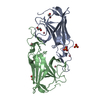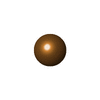+ Open data
Open data
- Basic information
Basic information
| Entry | Database: PDB / ID: 8t7l | ||||||
|---|---|---|---|---|---|---|---|
| Title | Copper bound HftA from Treponema denticola | ||||||
 Components Components | Pathogen-specific surface antigen, putative | ||||||
 Keywords Keywords | METAL BINDING PROTEIN / Lipoprotein / Iron transport / Periplasmic | ||||||
| Function / homology | Periplasmic metal-binding protein Tp34-type / Periplasmic metal-binding protein Tp34-type superfamily / Fe2+ transport protein / Prokaryotic membrane lipoprotein lipid attachment site profile. / metal ion binding / COPPER (II) ION / Pathogen-specific surface antigen, putative Function and homology information Function and homology information | ||||||
| Biological species |  Treponema denticola ATCC 35405 (bacteria) Treponema denticola ATCC 35405 (bacteria) | ||||||
| Method |  X-RAY DIFFRACTION / X-RAY DIFFRACTION /  SYNCHROTRON / SYNCHROTRON /  MOLECULAR REPLACEMENT / Resolution: 1.89 Å MOLECULAR REPLACEMENT / Resolution: 1.89 Å | ||||||
 Authors Authors | Corbett, B.W. / Suits, M.D. | ||||||
| Funding support |  Canada, 1items Canada, 1items
| ||||||
 Citation Citation |  Journal: To Be Published Journal: To Be PublishedTitle: Structural and functional characterization of the high-affinity ferrous iron transport protein HftA from Treponema denticola Authors: Corbett, B.W. / Suits, M.D. | ||||||
| History |
|
- Structure visualization
Structure visualization
| Structure viewer | Molecule:  Molmil Molmil Jmol/JSmol Jmol/JSmol |
|---|
- Downloads & links
Downloads & links
- Download
Download
| PDBx/mmCIF format |  8t7l.cif.gz 8t7l.cif.gz | 91.1 KB | Display |  PDBx/mmCIF format PDBx/mmCIF format |
|---|---|---|---|---|
| PDB format |  pdb8t7l.ent.gz pdb8t7l.ent.gz | 55.4 KB | Display |  PDB format PDB format |
| PDBx/mmJSON format |  8t7l.json.gz 8t7l.json.gz | Tree view |  PDBx/mmJSON format PDBx/mmJSON format | |
| Others |  Other downloads Other downloads |
-Validation report
| Summary document |  8t7l_validation.pdf.gz 8t7l_validation.pdf.gz | 1.2 MB | Display |  wwPDB validaton report wwPDB validaton report |
|---|---|---|---|---|
| Full document |  8t7l_full_validation.pdf.gz 8t7l_full_validation.pdf.gz | 1.2 MB | Display | |
| Data in XML |  8t7l_validation.xml.gz 8t7l_validation.xml.gz | 13.9 KB | Display | |
| Data in CIF |  8t7l_validation.cif.gz 8t7l_validation.cif.gz | 18.7 KB | Display | |
| Arichive directory |  https://data.pdbj.org/pub/pdb/validation_reports/t7/8t7l https://data.pdbj.org/pub/pdb/validation_reports/t7/8t7l ftp://data.pdbj.org/pub/pdb/validation_reports/t7/8t7l ftp://data.pdbj.org/pub/pdb/validation_reports/t7/8t7l | HTTPS FTP |
-Related structure data
| Related structure data |  8t7mC  3pjlS S: Starting model for refinement C: citing same article ( |
|---|---|
| Similar structure data | Similarity search - Function & homology  F&H Search F&H Search |
- Links
Links
- Assembly
Assembly
| Deposited unit | 
| ||||||||||
|---|---|---|---|---|---|---|---|---|---|---|---|
| 1 |
| ||||||||||
| Unit cell |
|
- Components
Components
| #1: Protein | Mass: 17328.225 Da / Num. of mol.: 2 Source method: isolated from a genetically manipulated source Source: (gene. exp.)  Treponema denticola ATCC 35405 (bacteria) Treponema denticola ATCC 35405 (bacteria)Gene: TDE_1511 / Production host:  #2: Chemical | ChemComp-SO4 / | #3: Chemical | #4: Water | ChemComp-HOH / | Has ligand of interest | Y | |
|---|
-Experimental details
-Experiment
| Experiment | Method:  X-RAY DIFFRACTION / Number of used crystals: 1 X-RAY DIFFRACTION / Number of used crystals: 1 |
|---|
- Sample preparation
Sample preparation
| Crystal | Density Matthews: 2.68 Å3/Da / Density % sol: 54.04 % |
|---|---|
| Crystal grow | Temperature: 291 K / Method: vapor diffusion, hanging drop / pH: 4.6 / Details: Sodium citrate, Ammonium sulphate, glycerol |
-Data collection
| Diffraction | Mean temperature: 100 K / Serial crystal experiment: N |
|---|---|
| Diffraction source | Source:  SYNCHROTRON / Site: SYNCHROTRON / Site:  CLSI CLSI  / Beamline: 08ID-1 / Wavelength: 0.95374 Å / Beamline: 08ID-1 / Wavelength: 0.95374 Å |
| Detector | Type: DECTRIS EIGER X 9M / Detector: PIXEL / Date: Aug 4, 2022 |
| Radiation | Protocol: SINGLE WAVELENGTH / Monochromatic (M) / Laue (L): M / Scattering type: x-ray |
| Radiation wavelength | Wavelength: 0.95374 Å / Relative weight: 1 |
| Reflection | Resolution: 1.89→42.17 Å / Num. obs: 30767 / % possible obs: 99.9 % / Redundancy: 12.6 % / Biso Wilson estimate: 33.67 Å2 / CC1/2: 0.997 / Rmerge(I) obs: 0.139 / Net I/σ(I): 11.9 |
| Reflection shell | Resolution: 1.89→1.99 Å / Redundancy: 11.3 % / Rmerge(I) obs: 0.08 / Num. unique obs: 1100 / CC1/2: 0.997 / % possible all: 99.2 |
- Processing
Processing
| Software |
| |||||||||||||||||||||||||||||||||||||||||||||||||||||||||||||||||||||||||||||
|---|---|---|---|---|---|---|---|---|---|---|---|---|---|---|---|---|---|---|---|---|---|---|---|---|---|---|---|---|---|---|---|---|---|---|---|---|---|---|---|---|---|---|---|---|---|---|---|---|---|---|---|---|---|---|---|---|---|---|---|---|---|---|---|---|---|---|---|---|---|---|---|---|---|---|---|---|---|---|
| Refinement | Method to determine structure:  MOLECULAR REPLACEMENT MOLECULAR REPLACEMENTStarting model: 3PJL Resolution: 1.89→42.17 Å / SU ML: 0.2356 / Cross valid method: FREE R-VALUE / σ(F): 1.38 / Phase error: 22.4986 Stereochemistry target values: GeoStd + Monomer Library + CDL v1.2
| |||||||||||||||||||||||||||||||||||||||||||||||||||||||||||||||||||||||||||||
| Solvent computation | Shrinkage radii: 0.9 Å / VDW probe radii: 1.1 Å / Solvent model: FLAT BULK SOLVENT MODEL | |||||||||||||||||||||||||||||||||||||||||||||||||||||||||||||||||||||||||||||
| Displacement parameters | Biso mean: 37.66 Å2 | |||||||||||||||||||||||||||||||||||||||||||||||||||||||||||||||||||||||||||||
| Refinement step | Cycle: LAST / Resolution: 1.89→42.17 Å
| |||||||||||||||||||||||||||||||||||||||||||||||||||||||||||||||||||||||||||||
| Refine LS restraints |
| |||||||||||||||||||||||||||||||||||||||||||||||||||||||||||||||||||||||||||||
| LS refinement shell |
|
 Movie
Movie Controller
Controller



 PDBj
PDBj









